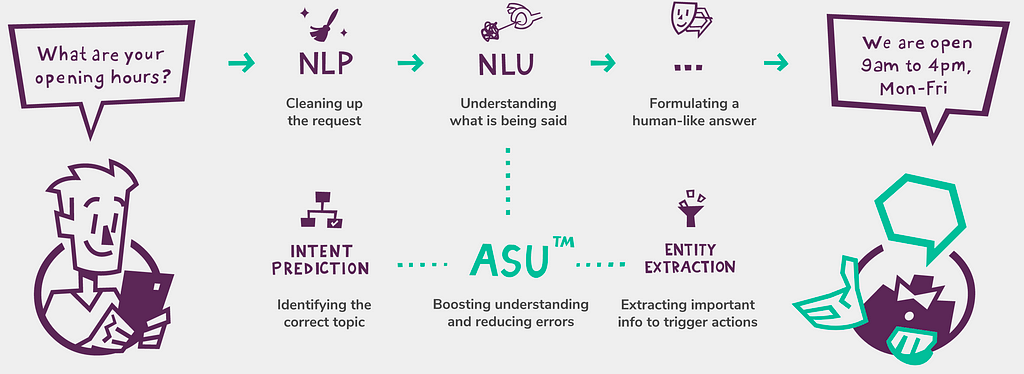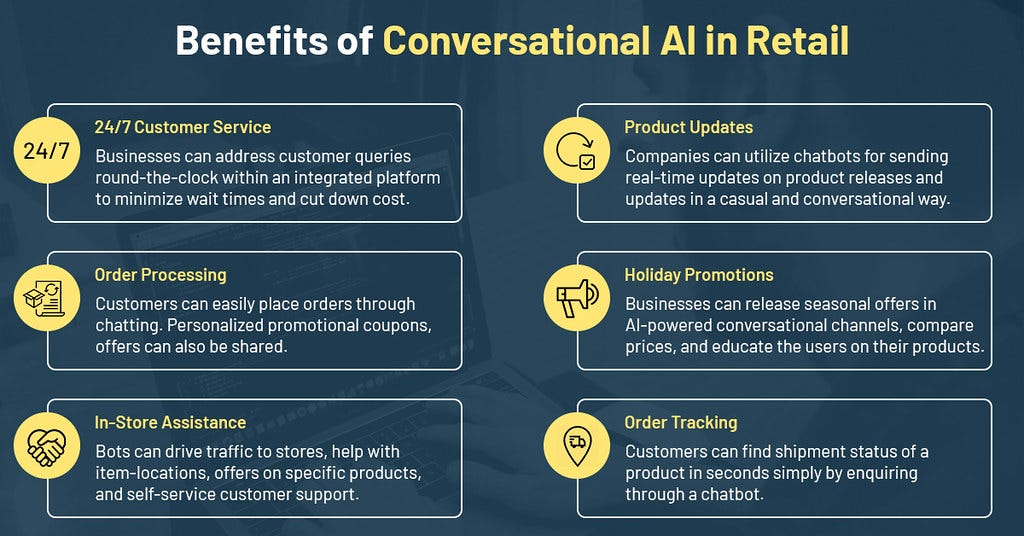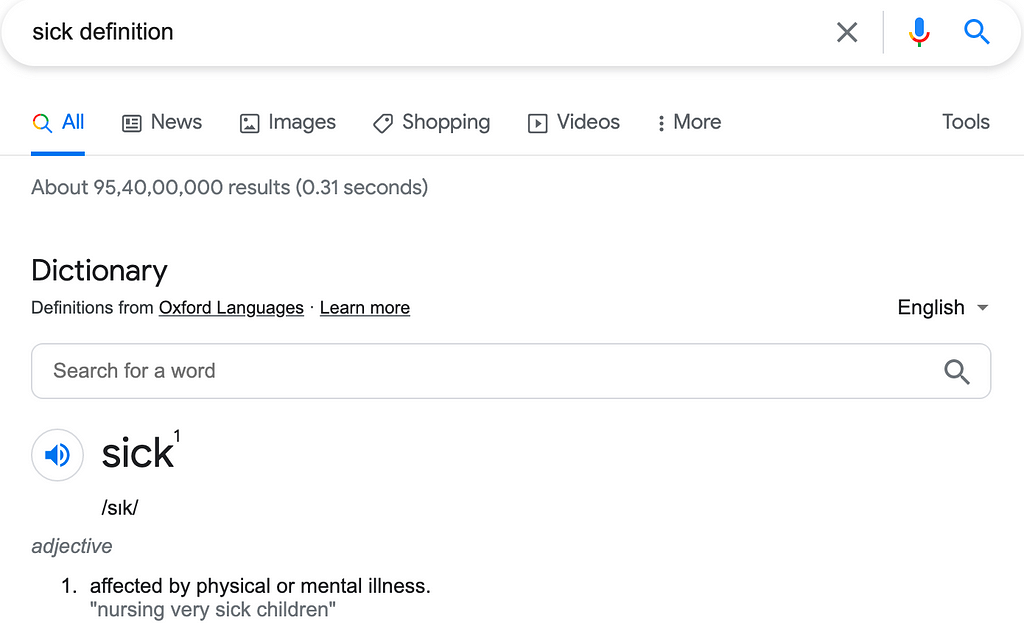
A Student Researcher’s view on Conversational AI
Last Updated on January 7, 2023 by Editorial Team
Last Updated on May 28, 2022 by Editorial Team
Author(s): Surya Maddula
Originally published on Towards AI the World’s Leading AI and Technology News and Media Company. If you are building an AI-related product or service, we invite you to consider becoming an AI sponsor. At Towards AI, we help scale AI and technology startups. Let us help you unleash your technology to the masses.
Images used in my articles are Properties of the Respective Organisations and are used here solely for Reference, Illustrative and Educational Purposes Only. (Images Source: Google [Aside from some images, in whose case, the source is specifically mentioned below the image])

What Exactly is Conversational AI?
- Conversational AI is the set of technologies behind automated messaging and speech-enabled applications that offer human-like interactions between computers and humans.
- It can communicate like a human by recognizing speech and text, understanding intent, deciphering different languages, and responding in a way that mimics a real-life human conversation.
- They use large volumes of data, Machine Learning, and Natural Language Processing to help imitate human interactions, recognize speech and text inputs, and translate their meanings across various languages.
So, in simple words, Conversational AI is the technology that allows users to ask questions to a machine and get automated responses, which are almost, like human responses, sometimes indistinguishable. (More on this later in the Article)
You might know some of the more popular ones: Siri, Alexa, Google Assistant, Cortana, etc. The main component in Conversational AI is the use of Natural Language Processing (NLP)
Components of Conversational AI
There are mainly 2 components of Conversational AI, namely-
Natural Language Processing
Under NLP there are four steps-
- Input Generation
- Input Analysis
- Output Generation
- Reinforcement Learning.
Unstructured data is transformed into a format that can be read by a computer, which is then analyzed to generate an appropriate response for the input. The Machine Learning algorithms improve response quality over time as it learns.
These four NLP steps can be broken down and explained further below:
- Input Generation: The Users provide input through a website or an app. The format of the input can either be voice or text.
- Input Analysis: If the input is text-based, the conversational AI will use Natural Language Understanding (NLU) to decipher and comprehend the meaning of the input and derive its intention. However, if the input is speech-based, it’ll use a combination of Automatic Speech Recognition (ASR) and NLU to analyze the data.
- Dialogue Management: During this stage, Natural Language Generation (NLG), a component of NLP, forms an appropriate response.
- Reinforcement Learning: Finally, machine learning algorithms refine responses overtime to ensure accuracy.
Let’s understand this better with 2 similar Examples.

Remember again, the input is as “Speech” in the above image, and hence Automated Speech Recognition (ASR) is used.
Here’s another similar Example

Benefits of Conversational AI

Customer-Centric
- Conversational AI helps deliver fast responses to all kinds of clients with different requests. Since customers are busy and therefore impatient — giving them quick responses is one of the easiest ways you can make their experience more delightful.
- Following the initial response, the Conversational AI may also play an important role in educating users through helpful prompts and probing questions. It’s incredibly common for customer support agents to give customers tutorials. With conversational AI, these tutorials can automatically leverage a client’s profile data to ensure customers are receiving personalized guidance.
- Finally, Conversational AI has proven itself a necessary and valuable guide for customers who aren’t sure where to go. When a customer doesn’t know where to go to solve a particular issue or a problem they have or to ask a simple query, Conversational AI can redirect people to the required place. For Instance, within banks, Conversational AI can help a lost customer where to go, and fulfill his or her requirement to apply for a loan, a credit card, etc.
Organisation-Centric
- Starting at the beginning of your customer’s experience, Conversational AI can help you better convert website visitors into leads through intuitive, easy-to-engage live chat windows, and chatbots.
- From here, Conversational AI may help improve your overall conversion rate from lead to purchaser. By asking tailored, and specific questions, chatbots excite customers and support sales team efforts.
Cost-Efficient
Staffing a Customer Service Department can be quite costly, especially as you seek to answer questions outside regular office hours. Providing customer assistance via conversational interfaces can reduce business costs around salaries and training, especially for small- or medium-sized companies. Chatbots and virtual assistants can respond instantly, providing 24-hour availability to potential customers.
Increased Sales and Customer Management
With the adoption of mobile devices into consumers' daily lives, businesses need to be prepared to provide real-time information to their end-users. Since conversational AI tools can be accessed more readily than human workforces, customers can engage more quickly and frequently with brands.
This immediate support allows customers to avoid long call center wait times, being put on hold, etc leading to improvements in the overall customer experience. As customer satisfaction grows, companies will see its impact reflected in increased customer loyalty and additional revenue from referrals.
Personalization features within conversational AI also provide chatbots with the ability to provide recommendations to end-users, allowing businesses to cross-sell products that customers may not have initially considered.
Scalability
Conversational AI is also very scalable as adding infrastructure to support conversational AI is cheaper and faster than the hiring and onboarding process for new employees. This is especially helpful when products expand to new geographical markets when expanding internationally or during unexpected short-term spikes in demand, such as during holiday seasons, when humans just can’t do the job as efficiently and as nicely as Conversational AI can.
Challenges faced by Conversational AI


Conversational AI had many challenges it faces, to keep up with the sprinting world, and remain a useful tool.
Constantly Changing forms of Communication
We, humans, change the way we communicate so often. What was once cool, and meant something means completely different now. For Instance, the Dictionary definition of the word “Sick” is “affected by physical or mental illness”. But in slang, the word also means amazing, or impressive, as shown in the above image.
From languages, dialects, and accents to sarcasm, emojis, and slang to emoticons, there are a ton of factors that can influence the communication between a human and a machine.
The same emoji might mean something completely different to this generation of people, versus its meaning to conventional, and old people. Conversational AI systems and bots need to keep up with what’s “normal” and what’s the “new normal” with human communication.
Security and Privacy
Especially when dealing with sensitive personal information that can be stolen, Conversational AI applications must be designed with security in mind to ensure that privacy is respected and all personal details and information are kept confidential to make sure there is no data being lost or stolen.
Discovery and Adoption
Although Conversational AI applications are becoming increasingly easy to use and normalized for the general population, there are still challenges that we need to overcome to increase the number of people who are comfortable using technology for a wider variety of use cases.
Educating your customer base on opportunities can help the technology be more well-received and create better experiences for those who are not familiar with it is very important, and is sometimes not looked upon, and executed properly, which leads to customers having bad experiences, not getting their query solved, or getting irritated.
Where we use Conversational AI
Source: IBM
We use Conversational AI across various fields. Some of them are listed below.
- Online Customer Support
- Accessibility
- HR Processes
- Healthcare
- IoT
- Computer Software
What is the Turing Test?
Here is a Ted-Ed video clearly explaining what the Turing Test is
I’d like to end this article with the Top 5 Questions on this topic. Make sure to take your time, understand the questions, and submit your answers via the comments below 🙂 The answers to the questions in this article will be available at the end of the next article!
Q1.
What is the difference between NLU and NLP?
Q2.
How do Organisations benefit from using Conversational AI?
Q3.
If the Input given by the Customer is Speech, then what is used to analyze the data?
Q4.
What do we do in the Stage of Dialogue Management?
Q5.
What is one of the biggest challenges faced by Conversational AI?
Thanks for Reading, Happy Learning!
A Student Researcher’s view on Conversational AI was originally published in Towards AI on Medium, where people are continuing the conversation by highlighting and responding to this story.
Join thousands of data leaders on the AI newsletter. It’s free, we don’t spam, and we never share your email address. Keep up to date with the latest work in AI. From research to projects and ideas. If you are building an AI startup, an AI-related product, or a service, we invite you to consider becoming a sponsor.
Published via Towards AI
Take our 90+ lesson From Beginner to Advanced LLM Developer Certification: From choosing a project to deploying a working product this is the most comprehensive and practical LLM course out there!
Towards AI has published Building LLMs for Production—our 470+ page guide to mastering LLMs with practical projects and expert insights!

Discover Your Dream AI Career at Towards AI Jobs
Towards AI has built a jobs board tailored specifically to Machine Learning and Data Science Jobs and Skills. Our software searches for live AI jobs each hour, labels and categorises them and makes them easily searchable. Explore over 40,000 live jobs today with Towards AI Jobs!
Note: Content contains the views of the contributing authors and not Towards AI.














